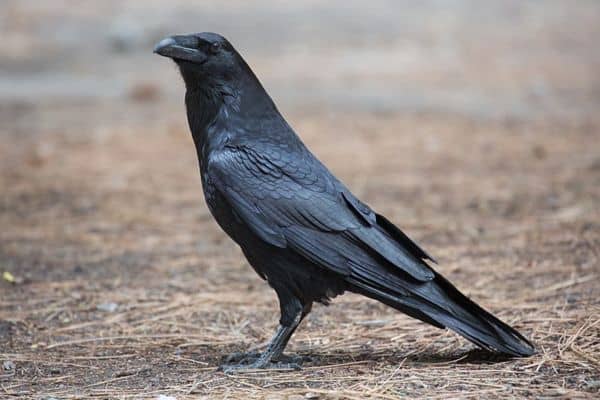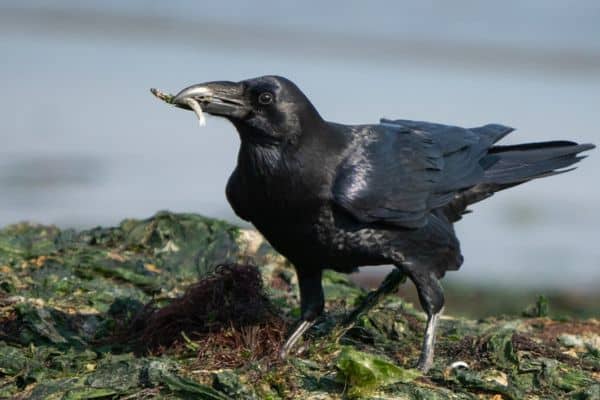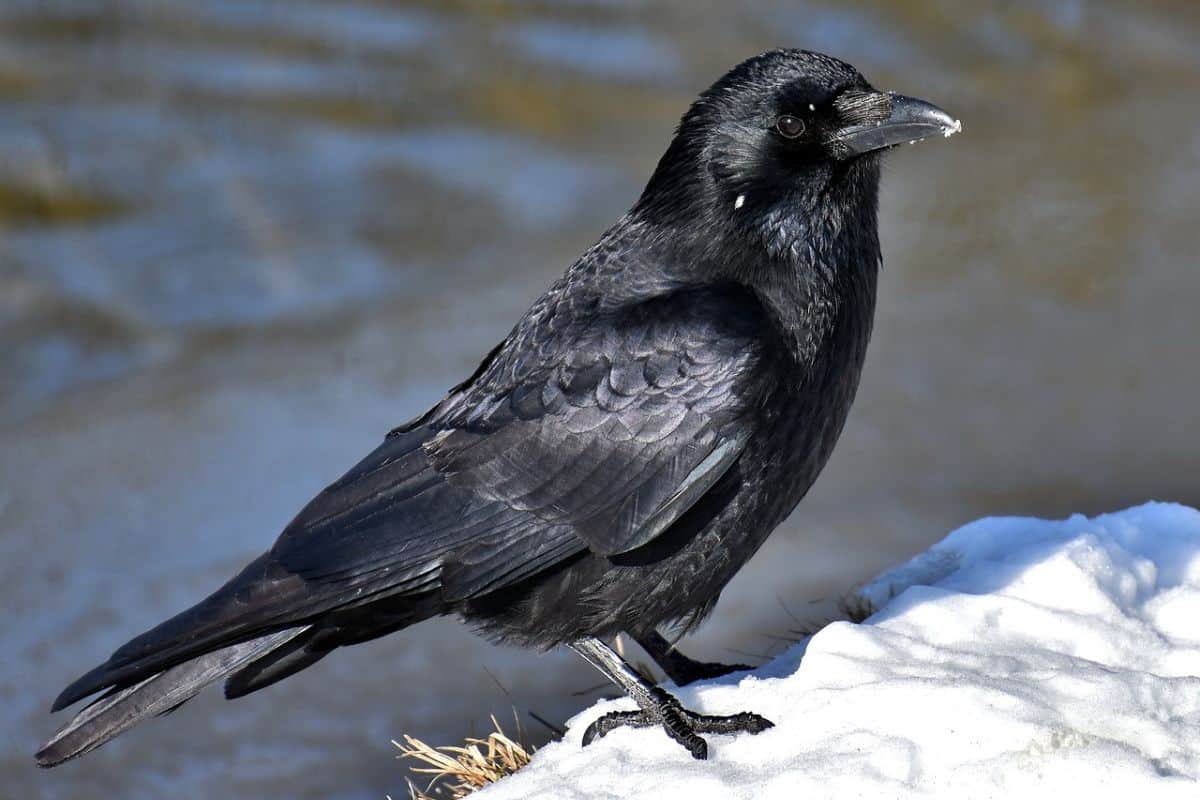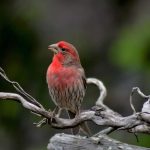Common Name: Common Raven
Scientific Name: (Corvus corax)| Size | Diet | Range in Hawaii | Status in Hawaii |
|---|---|---|---|
| 24 in. - 27 in. | small mammals, birds, eggs, insects, fruits, nuts, seeds and garbage | Unknown | Least Concern |
The Common Raven (Corvus corax) is a large and intelligent bird species that is found throughout much of the Northern Hemisphere. With its glossy black plumage and distinctive croaking call, this raven is a fascinating bird to observe in the wild.
Although it is not a native species to Hawaii, Common Ravens have been spotted occasionally on the islands as non-breeding visitors or vagrants, making for a rare and exciting sighting for birdwatchers. In this article, we’ll explore the fascinating world of the Common Raven and learn more about its unexpected presence in Hawaii.
Common Raven
Appearance

The Common Raven is a large and impressive bird, known for its distinctive appearance. It has a glossy black plumage, a stout and powerful bill, and a wedge-shaped tail.
With a wingspan ranging from 46 to 56 inches (117 to 142 cm) and a length of about 24 to 27 inches (61 to 69 cm), the Common Raven is one of the largest songbirds in the world. Its size, combined with its deep black coloration, makes it easily recognizable in flight or perched on trees and other elevated structures.
Diet
The Common Raven has a highly adaptable and opportunistic diet. It is known for being omnivorous, meaning it consumes both plant and animal matter. The diet of the Common Raven includes a wide variety of food sources such as carrion (dead animals), small mammals, birds, eggs, insects, fruits, nuts, seeds, and even garbage or human-provided food.
Ravens are also known for their scavenging abilities, often feeding on carcasses left behind by other animals. Their intelligence and resourcefulness enable them to exploit a diverse range of food resources, making them successful foragers in various habitats.
Nesting
The Common Raven builds its nest in various locations, including tall trees, cliffs, and man-made structures such as buildings or utility poles. The nest is typically large and constructed with twigs, sticks, and other plant materials.
Ravens are known for their impressive nest-building skills, creating sturdy and well-constructed nests. The nests are often bulky and may be lined with softer materials such as moss, grass, or fur.
Ravens tend to reuse and add to their nests year after year, resulting in substantial structures that can grow in size over time. The nests are usually found in elevated positions, providing safety and a good vantage point for the ravens to observe their surroundings.
Behavior

The Common Raven displays various nesting behaviors. They are known for their complex social structure and intelligent behavior. Ravens are monogamous and form long-term pair bonds. They often mate for life and both parents actively participate in nesting activities. They exhibit cooperative breeding, where non-breeding individuals within a group assist in raising the young.
Nesting behavior begins with the selection of a suitable nest site, which can be a tree, cliff ledge, or man-made structure. Ravens build large and sturdy nests using twigs, sticks, and other plant materials.
They may also incorporate softer materials like moss, grass, or fur for lining. Nests are often reused and added to year after year, resulting in substantial structures.
Both male and female ravens contribute to nest construction. They engage in elaborate aerial displays and vocalizations as part of their courtship rituals.
After mating, the female typically lays 3-7 eggs, which are incubated by both parents for about 18-21 days. During incubation, the male provides food for the female.
Once the eggs hatch, both parents take on the responsibility of feeding and caring for the chicks. Ravens are known for their clever foraging techniques and may engage in cooperative hunting to provide food for their young.
The chicks grow rapidly and are dependent on their parents for several weeks. They fledge at around 35-42 days old but may remain with their parents for an extended period, learning essential skills and social behaviors.
The nesting behavior of Common Ravens showcases their intelligence, strong pair bonds, and cooperative nature, contributing to their successful reproduction and survival as a species.
Habitat
The Common Raven is a highly adaptable species found in a wide range of habitats. They are well-known for their ability to thrive in diverse environments. Ravens can be found in forested areas, open woodlands, grasslands, deserts, coastal regions, and even urban areas.
When it comes to nesting, Common Ravens typically prefer tall trees, cliffs, or rocky ledges as nest sites. Forested habitats with mature trees provide suitable nesting locations, offering protection and stability for their large nests. Cliffs and rocky outcrops serve as natural nesting sites, providing elevated platforms that are inaccessible to predators.
While trees and cliffs are the primary choices for nesting, ravens are also known to adapt and use man-made structures such as buildings, transmission towers, and bridges. They can take advantage of these elevated structures, mimicking their natural nesting preferences.
Range
The Common Raven is a widespread Holarctic species, but in Hawaii, its range is limited to occasional vagrant individuals or non-breeding visitors. There is one documented record of a Common Raven observed on Kure Island in the Northwestern Hawaiian Islands. This species is not a resident breeder in Hawaii and is rarely seen in the islands.
Conservation Status

The conservation status of the Common Raven is generally stable and it is not considered a globally threatened species. The International Union for Conservation of Nature (IUCN) lists the Common Raven as a species of “Least Concern.”
The population of Common Ravens is widespread and their adaptability to various habitats contributes to their stable status. They are not currently facing significant threats that would cause a decline in their numbers at a global level.
Interesting Facts
1. Vocal abilities
Ravens have an impressive vocal repertoire. They can mimic a wide range of sounds, including human speech, other bird calls, and even non-natural sounds like car alarms or machinery.
2. Aerobatic displays
Ravens are highly acrobatic in flight. They are known for their playful aerial displays, which include soaring, rolling, and even somersaulting. These displays are believed to serve social and territorial purposes.
3. Tool use
Common Ravens are capable of using tools to obtain food. They have been observed using sticks to extract insects from tree crevices and even dropping nuts or hard objects onto hard surfaces to crack them open.
4. Playfulnes
Ravens exhibit playful behaviors, engaging in games like aerial acrobatics, sliding down snowy slopes, or even playing “tug-of-war” with other ravens or animals.
Frequently Asked Questions
1. Are Common Ravens and crows the same bird?
No, Common Ravens and crows are different bird species, although they are both members of the Corvidae family. Ravens are larger in size and have a more robust build compared to crows.
2. Are Common Ravens considered pests?
While some people may perceive Common Ravens as pests due to their scavenging behavior, they also play important ecological roles as scavengers and predators, helping to maintain healthy ecosystems.
3. Do Common Ravens have a complex social structure?
Yes, Common Ravens exhibit complex social behaviors and have a hierarchical social structure. They form family groups and engage in cooperative activities like foraging and defending territories.
4. Are Common Ravens considered symbols of death or bad luck?
In some cultures and folklore, Common Ravens have been associated with death or bad luck. However, they also hold positive symbolism in other cultures, representing wisdom, intelligence, and protection.




